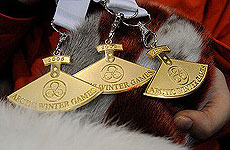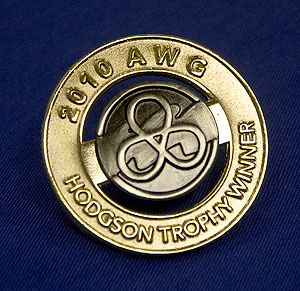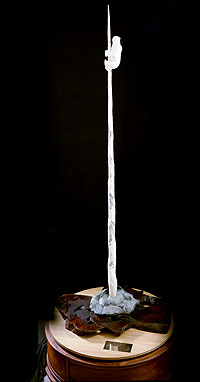
Ulus & Awards
 For
athletes at the Arctic Winter Games, there is no greater thrill than
winning an ulu. The medal’s name and shape are borrowed from the
all-purpose knife traditionally used by the Inuit. Ulus are awarded in
bronze, silver, and gold; recognizing the hard work and commitment of
athletes with a unique memento from the North.
For
athletes at the Arctic Winter Games, there is no greater thrill than
winning an ulu. The medal’s name and shape are borrowed from the
all-purpose knife traditionally used by the Inuit. Ulus are awarded in
bronze, silver, and gold; recognizing the hard work and commitment of
athletes with a unique memento from the North.
For
many of the sports featured in the Arctic Winter Games, medals are
awarded at individual sport venues as winners are determined.
Traditional ‘Medal Rounds’ will occur in only five of 21 sports;
basketball, curling, hockey, soccer, and volleyball.
The Hodgson Trophy
 Despite
the obvious importance of a competitive spirit in athletic
competitions, the Arctic Winter Games have always emphasized fair play
over the need for victory. Since its introduction in 1978, the Hodgson
Trophy symbolizes the ideals of fair play and team spirit, and is
awarded to the participating contingent who best embodies those ideals.
Team members also receive a unique pin in recognition of this
accomplishment.
Despite
the obvious importance of a competitive spirit in athletic
competitions, the Arctic Winter Games have always emphasized fair play
over the need for victory. Since its introduction in 1978, the Hodgson
Trophy symbolizes the ideals of fair play and team spirit, and is
awarded to the participating contingent who best embodies those ideals.
Team members also receive a unique pin in recognition of this
accomplishment.
 Donated
by Commissioner Stuart Hodgson, this distinctive trophy is a
one-of-a-kind piece of Inuit artwork from the Canadian Arctic. Its main
feature is a six-foot high narwhal tusk mounted on a soapstone base and
decorated with scrimshaw. A carved walrus wraps itself around the tusk
at the base, and a carved bear clings to the tusk’s upper reaches,
symbolizing the efforts of participants to reach for the top through
their endeavors.
Donated
by Commissioner Stuart Hodgson, this distinctive trophy is a
one-of-a-kind piece of Inuit artwork from the Canadian Arctic. Its main
feature is a six-foot high narwhal tusk mounted on a soapstone base and
decorated with scrimshaw. A carved walrus wraps itself around the tusk
at the base, and a carved bear clings to the tusk’s upper reaches,
symbolizing the efforts of participants to reach for the top through
their endeavors.
Votes from
mission staff, registered coaches, major officials from each sport,
Arctic Winter Games International Committee members, registered media,
and the President, General Manager, and Sport Manager for the Host
Society are tallied to award the trophy in a ceremony that highlights
each Arctic Winter Games.
Previous Winners:
1978 – Alaska
1980-88 – Yukon
1990 – Alaska
1992 – Northwest Territories
1994 – Greenland
1996 – Northwest Territories
1998 – Yukon
2000 – Nunavut
2002 – Greenland
2004 – Nunavut
2006 – Alaska
2008 – Nunavut